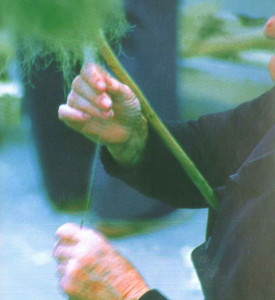
 In those days flax fibre manufacturing played an important role in Euskal Herria and the whole world. Until the beginning of the 20th century, flax fibre and sheep wool were the main raw materials employed to produce fabric, cloth, and so on. Young girls used to sow flax in a small piece of land, and year after year they managed to assemble handmade bedlinen and clothing for their wedding. As well as being in charge of the house chores, women took responsibility to sow the flax seeds, look after the crop and finally extract the fibre from the plant.
In those days flax fibre manufacturing played an important role in Euskal Herria and the whole world. Until the beginning of the 20th century, flax fibre and sheep wool were the main raw materials employed to produce fabric, cloth, and so on. Young girls used to sow flax in a small piece of land, and year after year they managed to assemble handmade bedlinen and clothing for their wedding. As well as being in charge of the house chores, women took responsibility to sow the flax seeds, look after the crop and finally extract the fibre from the plant.
Flax fibre manufacturing is an extremely long and arduous process, as the old saying goes: “Linuaren atsekabeak, amaigabeak” (The fatigues of flax manufacturing are endless).
Flax was sowed in September, in fields where maize, wheat or potato had been harvested from. Flax planting was advisable to be done on Saint Linus’ Day, 23 September; the plant would then be ready for collection the following year between Saint John’s Day and Saint Marina’s Day. Flax was pulled up by the roots, plant by plant; it was allowed to dry in the field for several days and then the bundles of flax were taken to the house and stored in the attic.
The next step was to remove the seeds, which was done by hitting the plant with a mallet or threshing the seed end using a toothed comb called garrama. The seeds were saved to be sowed. The flax was transported in the cart or by mule to a stream or pond and was submerged to soak for ten or fifteen days until it softened. The bundles of flax were tied together and stones placed on top so that a flooding would not drag them along, as the lyrics of the song reveal.
After a fortnight the retted bundles were returned to the house, untied and spread on the yard in the sunshine until the flax dried and its skin cured. Next the flax was beaten once and again against a threshing stone, linarria, placed in the porch or with the help of a mallet, until the waste material or shrives were shed. This, linarriketa, was an extremely tough job usually done by men. Breaking processes followed later, ezpatatu and trangatu, whereby the stalks of flax loosened and became tender, and the wood and straw were separated from the fibre. Flax breaking was often communal work done in the evening. When the work was finished, a supper consisting on roasted chestnuts and a vowl of milk, sorgin-afaria or linafaria, was offered to the volunteers. Fun, dance, singing and enjoyment followed.
The dressing of the flax, liho-apainketa, continued with the scotching, suhasketa, in order to pull away pieces of the stalk and further soften and loosen it, an operation repeated at least three times for best results. The heckling, orrazketa, was part of the dressing process, which involved pulling the fibre through a heckling comb or txarrantxa; a bed of ten-to-twelve-centimetre-long nails driven to a wooden block. The more the fibre was combed, the finer yarn it would produce. Three types of flax fibre were differenciated: amukoa or kirrua was the most refined and suitable for bed sheets and men’s shirts; muiloa, a bit rougher; and finally mukerra or burutxa, which was the coarsest.
At this point the thread was ready to be span, irun or goruetan egin, a process by which the yarn was twisted into thread and then woven into fabric to become textiles: bed sheets, shirts, kerchiefs, and so on. As the well-known song titled O Pello, Pello! remarks, it is a truly lengthy proceeding which would take us too long to describe in detail; therefore, we shall account for it very briefly. The thread was span, irundu; wound, astalkatu; bleached, zuritu; curled up, harilkatu; woven, irazkitu, cut, pikatu; and sewed, josi. These were some of the main winter chores of mothers and grandmothers of yesteryear.


